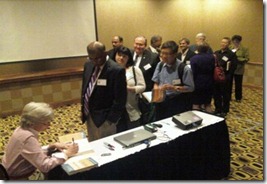A former student keeps me up on the popular press. His recent send is from the Atlantic Monthly: “The 14 Biggest Ideas of the Year.” The article is well worth a read.
The list will be fascinating to anyone interested in social change and modern times. It’s invaluable for understanding evolving and under-served markets and for developing new products and services for them. Here’s the list – in descending order for drama – and a few comments on each item for clarity.
What are the implications for your organization? For your career? For our collective future?
14. The Green Revolution Is Neither: Solutions are expensive. Progress has been slow. We’re still too dependent on fossil fuel. In 2010, only one-tenth of our electricity came from renewable sources. Kermit the Frog got it right. It’s not easy being green.
13. The Maniac Will Be Televised: In a world of expanding social media, it takes something pretty wild and loud to cut through the noise. Charlie Sheen. Donald Trump. Colonel Qaddafi. Bottom-line, “the electronic brain of the new media has an affinity for suspicious minds.” Amen.
12. The Players Own the Game: Think LeBron James. Superstar and media darling at age 18. His move to the Miami Heat was a big deal and a sign of change in athlete culture: players realizing their power and fans wanting them to have and leverage it.
11. Gay Is the New Normal: In 2010 and for the first time, a majority of Americans (52 percent) called homosexuality morally acceptable. Will opponents of gay rights now be an oppressed minority?
10. Bonds Are Dead (Long Live Bonds): Long-term interest rates are rising slowly. The Fed has been propping up bond prices, as the government keeps selling them off to pay for the stimulus. Bonds aren’t going away, but if the Fed wishes it were out of the bond market, what does that say for the rest of us?
9. The Next War Will Be Digitized: The controller of “the cloud” controls the world. Geostrategy looks to an opponent’s vulnerabilities and seeks to concentrate damage in places that do the most harm. Controlling everyone’s data is a lot more powerful than a few harbors, office buildings, or airports.
8. Grandma’s in the Basement (and Junior’s in the Attic): Census figures show the number of Americans ages 25 to 34 living with parents up to 5.5 million or 13 percent of that age. Grandparents are moving in with children, propelled by everyone’s need to save in tough times. The multi-generational family household is back in numbers not seen since the 1950s – and the American family is redefined.
7. Public Employee, Public Enemy: Wisconsin Governor Scott Walker has led the charge, and public unions are on radar screens now for conservatives out to bust them and liberals surprised they care.
6. Wall Street: Same as It Ever Was: So what’s changed if: (a) the big banks are bigger than ever; (b) “interconnectedness” has increased – financial assets are moving in conjunction with one another and rising together. Another crisis, everything falls at once; and (c) Wall Street pay is back at record highs?
5. The Arab Spring Is a Jobs Crisis: Euphoria has turned to depression. Uprisings did little to improve daily life. Emigration is up. Tourism down – by 75 percent in Egypt. No workable strategies are easy for economic security or social justice anytime soon. Unemployment is huge. One hundred million – 1/3 of the Arab world – are in the job-hungry age range of 15 to 29. Can new crises be far away?
4. Elections Work: Whether you agree with the Tea Party or not, they have brought activism and excitement onto the U.S. political stage – and a reminder that our actions at the polls mean something.
3. The Rich Are Different From You and Me: Super rich is a global phenomenon. We see it in developed economies like the U.S., United Kingdom, and Canada, and in developing economies like China and India. The very, very rich are leaving the rest of us behind. Income inequality is increasing at a rapid rate, especially for minorities and the U.S. and European middle classes hit hard by the recession.
2. Nothing Stays Secret: Internet. Facebook. WikiLeaks. Transparency is in. No one is spared. Too risky to say more.
1. The Rise of the Middle Class—Just Not Ours: The middle class in the U.S. and Europe are “squeezed.” The economy isn’t rebounding, incomes for most are not rising, and median household income has declined in real terms. But it’s a different story for the BRICs (Brazil, Russia, India, and China). Income per capita has soared. Jobs are increasing. Education improving. The bright side to this story: rising affluence means rising consumption. Do we have our products and services ready?
